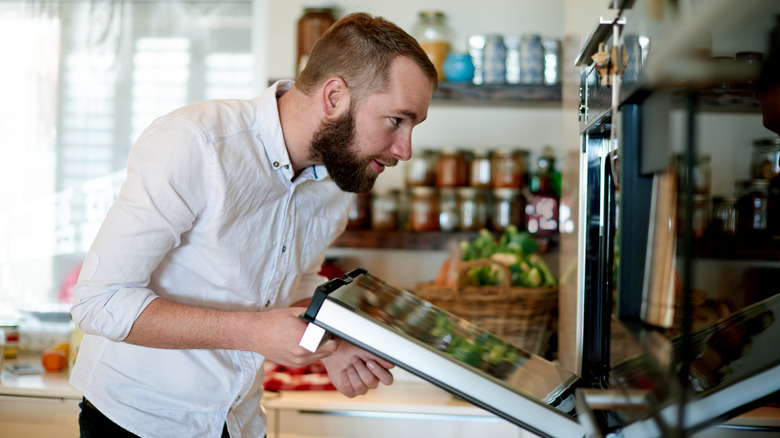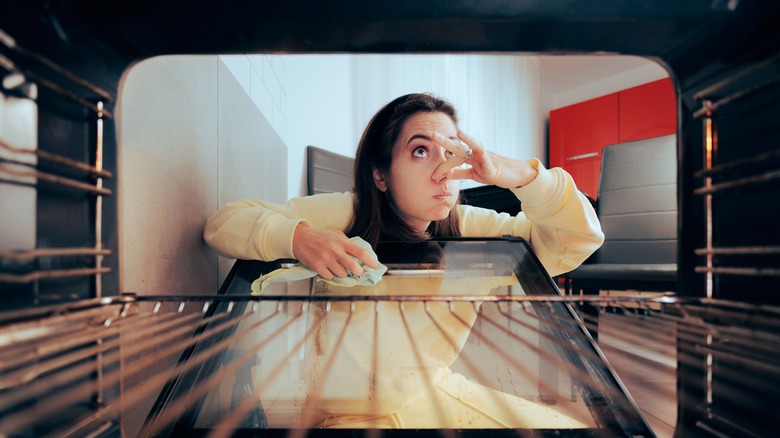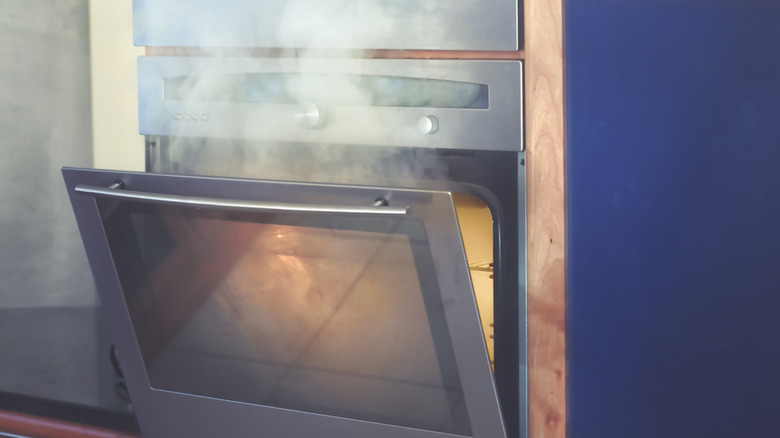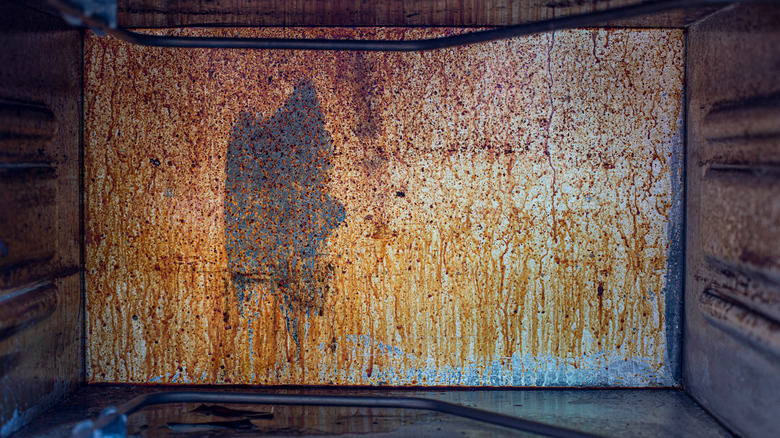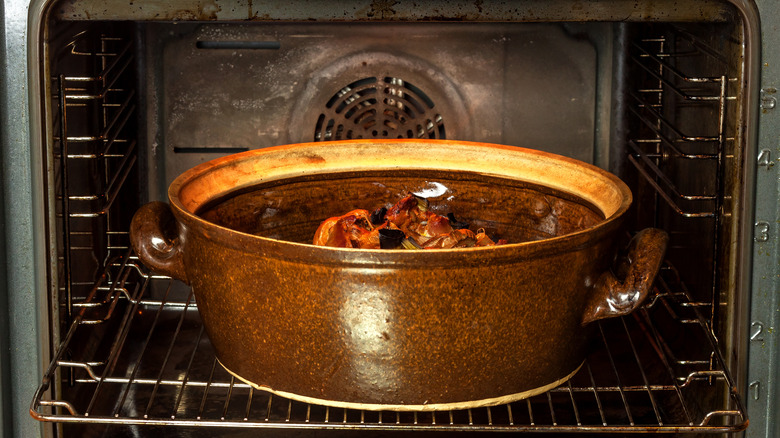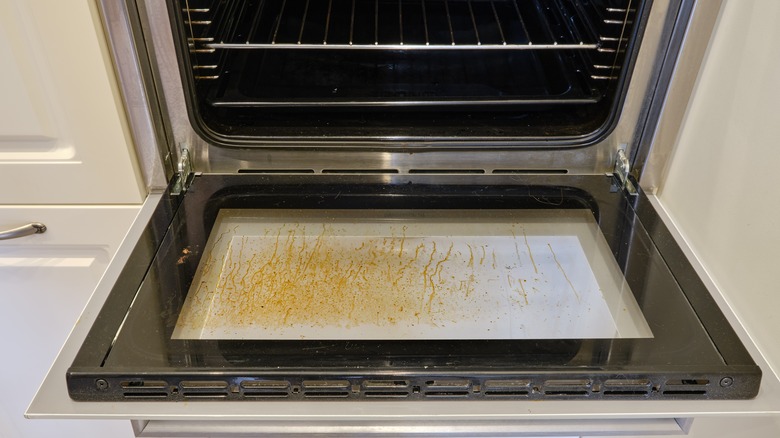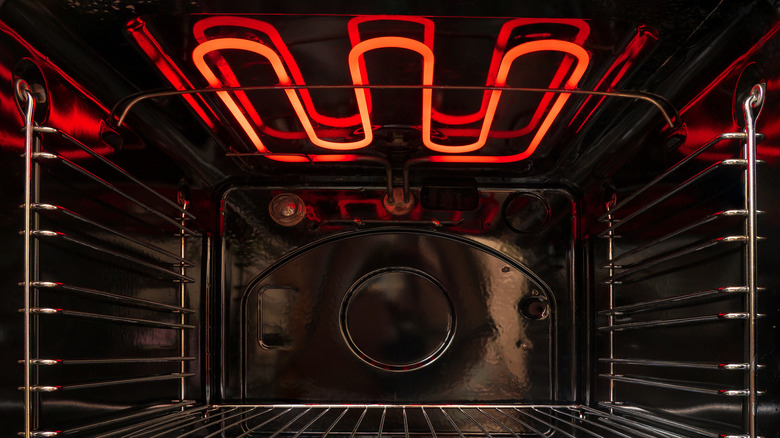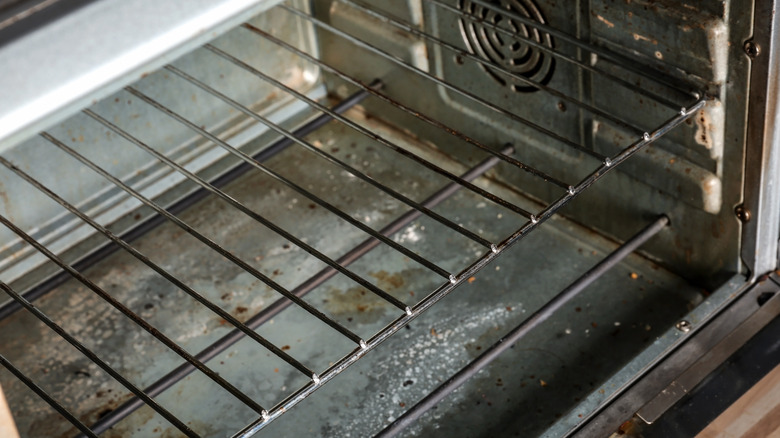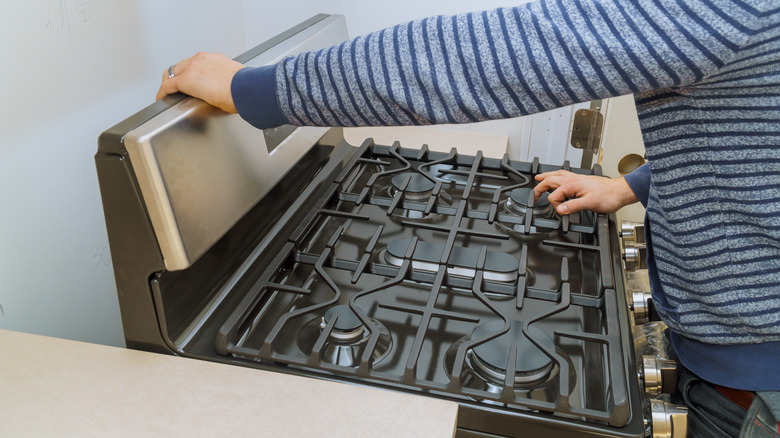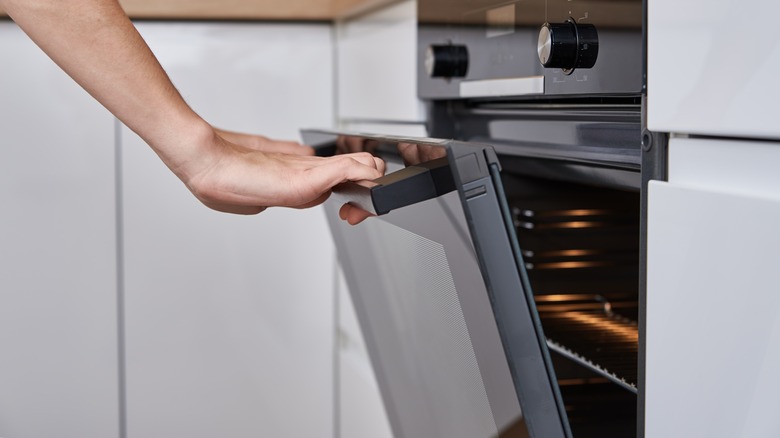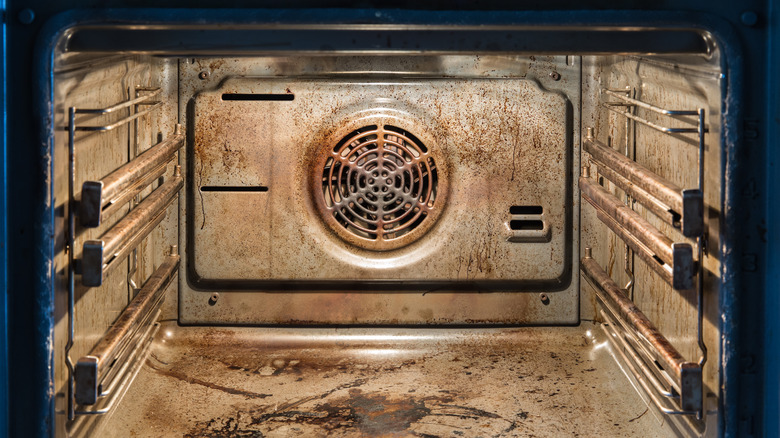11 Signs You Really Need To Clean Your Oven
Your oven is probably one of the dirty areas in your kitchen that deserve more attention. It's easy to overlook because it can fall into the "out of sight, out of mind" category. You might notice it needs some work when you take something out of it, and then by the time you let the oven cool, it slips your mind again. However, sometimes the signs aren't so obvious, so it's crucial to recognize different indicators.
For example, you need to clean more than just the bottom of the chamber and should include the whole interior, from the door hinges to the glass window. Whether you use your appliance to make dinner every single night or you mostly bake desserts in it, your food comes out better when you cook it in a clean environment. And most importantly, your oven can continue to run smoothly for years to come when you take proper care of it.
1. It has a strange odor
If you notice a funky smell when you turn on your oven or open it to put food inside, you need to get in there and clean it. After all, when you cook food, the last thing you want is for family or guests to lose their appetite from the smell of your appliance. Your oven can take on many unpleasant odors, depending on what you cook and how you maintain it. For instance, certain foods like meats are fatty, so if the grease ends up on the oven walls or bottom, the odor lingers for weeks.
It might seem like a pain to fully wrap your baked ribs with foil, but it tremendously helps prevent gnarly odors from forming. Additionally, if you use the self-cleaning feature on your oven, you might think it's convenient, but it can make your oven smell funky too. Specifically, it might have a burnt smell to it (but burnt aromas might also come from food if you forget to take something out of the oven in time, so it is definitely circumstantial). Ultimately, to eliminate these lingering smells, it's best to manually clean it yourself instead of running the self-cleaning mode, which can worsen it.
2. It smokes when you turn it on
Your oven doesn't smoke for absolutely no reason. In fact, there are multiple reasons why it might, like if you use a new oven for the first time or if there's something wrong with a heating element. However, assuming that you've had your oven for a while and it is in good shape mechanically, its lack of cleanliness might be at fault.
There could be tiny burnt bits hiding or greasy remnants from foods with cooking oil or fat. These foods have smoke points when you heat them, which you might notice if you sauté something on high or place your food close to the broiler. But just because the fat splashes onto the oven wall doesn't mean it's suddenly immune to smoking. The longer the grease builds, the more noticeable the smoke is.
Of course, the smell is quite recognizable, so you might notice it when your oven is on preheat before you even open the door. If not, the smoke might escape slowly or quickly rush out when you go to cook something, depending on how heavy it is. Unless a big piece of burnt food is the sole culprit, it is best to turn the oven off and use another cooking method for the day so that the oven can cool and you can clean it properly.
3. There are visible food particles and grime
One of the most apparent indicators that you need to clean your oven is if it's visibly dirty, whether on the racks, walls, or the bottom of the chamber. The residue is usually dark and might be sticky, which makes it a bigger job than simply wiping it with a wet towel. Other times, when you touch it with your finger, a black powder might transfer to your skin. Most likely, it takes time for this accumulation to happen. Another possibility is that you recently cooked something, and it spilled over, but you didn't address it immediately. Then, you used the oven again, and everything got caked on.
Remember, with tiny food particles, you further cook them every time you turn the oven on, so after so many times, they turn ashy. The best way to clean the buildup is to apply the cleaner and let it soak for some time, which softens everything and makes it easier to work with. Remove the racks first, whether you use a chemical cleaner, like Easy-Off, or go a more natural route, like water and vinegar. Even if you don't necessarily need to scrub the shelves, it is difficult to reach every nook and cranny with them in the way. You can also use special sponges or take advantage of a wet pumice stone to help scrub off tough, excess grime.
4. The fan isn't working as well
If you own a convection oven, it has slightly different parts than a conventional one, the most significant being the fan. When the fan moves in a convection oven, it swirls around the hot air so that the food cooks more uniformly. However, if food, pieces of foil, or other debris end up in the fan, it loses efficiency.
A slower fan or no fan means that you miss out on the benefits of a convection oven, not to mention that it's also a fire hazard to have things caught in it. Unfortunately, even if you cleaned your oven the other day, debris can latch onto the fan at any time, so it's not always a slow-growing problem. Hence, it's a good idea to take a quick peek at this part of the oven every time you use it.
On the other hand, the issue might just be dust buildup (you can use a flashlight to check this). Either way, ensure the oven is off before you touch or remove something from it. You can go the extra mile and unplug it as a safety measure, so there is no chance of your hand accidentally getting caught. Lightly dampen a cloth with soap and warm water to clean the dust off of the fan; even a step this small makes a massive difference in how smoothly the blades run.
5. You can't see through the window
One of the most convenient features of modern ovens is that they have a window that you can look through to see how the food is doing. But when the window has a film on it, it makes it difficult to see what's inside. Although it usually takes time for this fogginess to occur, don't wait until it is time to spring clean your whole kitchen to address it. The dirty glass affects your cooking, especially with fragile things like cakes, for example. Because if you continuously open the oven to check on the food, it can collapse the cake from the oven losing hot air and gaining colder air.
Therefore, you need to know the proper steps to keep the window clean. To focus on this part of the oven, gather some rags, water, dish soap, and baking soda (or vinegar). If you want to use baking soda, you can dissolve it in water, which makes it easy to apply. Meanwhile, if you make a mixture of vinegar and water, it works better on tough stains. You can also add some dish soap, which helps. Whichever you use, have patience and let it sit on the glass window for up to 20 minutes before you wipe and scrub it off.
6. Your food tastes off
Sadly, when you cook in a neglected oven, the dirty environment can take a toll on more than just the appliance's window or fan. It may come as a surprise, but the fumes that linger from previously cooked food can have an impact on the taste and quality of the food you're currently preparing. This is especially an issue when you cook the dishes without covering them with foil or a lid, as the fumes have free access to permeate the surface.
While you may not notice it with things like meats and veggies, it can affect other foods like bread or desserts more apparently. It's easier to tell with these foods because they're supposed to be sweet, so any funky flavors stick out like a sore thumb. However, that doesn't mean your dinner is safe either, so soon as you notice that this is an issue, you need to give the oven a nice clean.
7. It has temperature problems
Ovens typically take 10 to 20 minutes to preheat fully, so if you notice that yours takes an extensive amount of time, it might be due to all the grease and gunk. Just as with any machine, when you neglect its maintenance, it performs worse, and its lifespan shortens because the caked-on dirt is strenuous on the appliance. On top of having preheating problems, it might even get so bad that it has trouble sustaining the correct temperature afterward. This negatively affects your meals if the temperature fluctuates.
First, it likely takes much longer to cook foods thoroughly with an oven that isn't hot enough, especially the center of thick dishes like casseroles. Secondly, foods like muffins need a stable temperature to rise, or they don't turn out right. This is why periodically checking your oven's temperature is essential, especially if you suspect it's inaccurate. You can use an oven thermometer to confirm this. Place it on the center rack and see if the gauge lines up with the temperature you set the oven to. If it is imprecise, you can give it a deep clean and see if the issues resolve.
8. The racks are darker
It's a wise move to examine the racks that hold your cookware because sometimes bubbling cheese or food clings to them. Other times, they're left uncleaned for an extensive amount of time, which makes them harder to slide, or they appear dull and have a dirty film. But another offender that might come as a surprise is the oven's self-cleaning feature.
Sadly, when you run this mode on the appliance and leave the racks inside, it can damage them. Specifically, companies often coat these shelves with chrome, which can't handle that level of heat. While some companies use porcelain coating for the racks, it's wise to remove them from the oven during this process anyway.
When you clean the shelves, do yourself a favor and clean them in an open space. It's nearly impossible to efficiently reach every spot on them when you try to clean them inside the oven. You can soak them in a large sink, bathtub, or storage tote. For example, place them in the tub and sprinkle on baking soda, followed by vinegar, which makes the soda bubble up. Then, add enough water to cover the racks and allow them to soak for several hours. You can even let them sit overnight to get rid of pesky grime. Rinse, wipe, and dry them before you reintroduce them to the appliance.
9. You just bought it
If you install a squeaky-clean oven, wiping it down might be the last thing on your mind. However, when companies make appliances, there are manufacturing chemicals and oils, so you certainly don't want to cook your food in an environment full of them. The concept of "burning in" your oven might be familiar. You turn the new oven to an ultra-high temperature and let it burn off any excess manufacturing residue. Read your appliance's owner's manual to know the exact temperature the company recommends for your oven. However, if you want it to be a clean slate when you first use it, you must go beyond just doing a burn-in session. To be extra safe, wipe the appliance's interior down with warm, soapy water before and after you burn it in.
Beforehand, use a damp sponge or microfiber cloth while the oven is still off, and try to remove as much of the oil as possible. The more you can take care of before you turn the oven on, the weaker the chemical smell is during the burn-in. Then, follow the user guide's steps to heat the oven and let it cool completely before you wipe it clean again. It's a process, so don't plan to cook anything the first few hours you have your new appliance. But this way, you can be sure you don't introduce chemicals to your dinner.
10. The door doesn't shut properly
If you own an older oven, it can become challenging to shut the door entirely. This negatively affects the oven's efficiency because hot air seeps out from the sides, which makes your house hotter and the oven colder. When you encounter this problem, it is essential to inspect the inner part of the door to figure out the root cause. Start by checking if the door lock is broken or if any of the racks are protruding out too far, which blocks it from entirely shutting.
If these aren't to blame, inspect the seal and hinges for built-up grease and grime. Wipe it with a damp towel and your cleaner of choice if needed. It takes a lot of gunk for the hinges not to work correctly, so you likely need to do several rounds of wiping, rinsing the towel, and wiping them down again. Moreover, food debris might stick in the bottom crack of the door, which causes an obstruction. This is an easy fix since you can just scoop or vacuum out the charred food pieces and continue your day.
11. It's been a while
Lastly, even if your oven doesn't have obvious issues, like a lousy door seal or inaccurate temperature, you still need to clean it every few months. If you can't remember the last time you did it, it's probably time to do so. Remember that not every part requires the same cleaning method. So, if you plan to scrub the whole thing, take note of which cleaning products to use on the chamber, the window glass, the racks, and the fan.
It's possible to get the job done with natural products, but if you use chemical cleaners, open the windows in your home to let some fresh air in. Otherwise, it can be dangerous to breathe in the fumes. Protective gear is a must – wear gloves to shield your skin and an odor-blocking mask. Depending on the type of chemical, goggles aren't a bad idea either. When it's been such a long time since you worked on it, it isn't going to be a quick task. You can always break it up into smaller projects and conquer a specific section each day to not overwhelm yourself.
